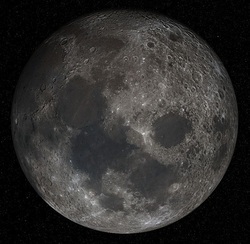the truth turned out to be so outlandish no one would have even suggested it.  Theia was a real planet, about the size of Mars, that orbited our sun when the solar system was new alongside Venus and Mercury and the Earth. We don't talk much about it now, because we don't see Theia as she was. But Theia is still there. It would be cool if I could tell you that Theia was obliterated in a mighty collision that blasted her wreckage into the rocky ring between the orbits of Mars and Jupiter that we call the Asteroid Belt. Alas, science has pretty much proven that the asteroids aren't remnants of a planetary explosion but just bits of flotsam left over from that same era, kept from ever forming a planet in the first place by Jupiter's gravitation. No, Theia didn't fracture into a ring of invisible smithereens. Theia's story is much more intimate to us. Theia crashed into the Earth. The Earth has been hit by large astronomical bodies many times. But this one was unique. The sheer size of Theia puts this cataclysm in a class all its own. Compared to Theia, the six-mile thick chunk of stone that killed the dinosaurs and ravaged Earth's climate for a million years was a BB. It took analysis of mineral samples brought back by the Apollo flights to reveal this amazing story. Before then, the origin of the Moon was a matter of educated speculation. The most accepted theory was that the Earth had "captured" a passing planetessimal that wandered into its gravity well by chance. There were problems with that theory, but there were worse problems with every other theory. And without physically examining the Moon up close, the mystery could not be solved. To make a long and complex story short, here's what the chemistry of the Moon rocks revealed. Some time more than 4 billion years ago, when all of the sun's terrestrial planets were lifeless worlds of fiery meteor showers and violent vulcanism, Theia and our Earth crashed together. But Theia didn't become our Moon. Earth was larger, but Theia was large enough to hold her own in the contest, and both planets were severely disrupted. Theia did shear into molten fragments, but the crash also blew out a huge section of our planet. As gravity sorted the pieces, the heavier minerals of Theia merged into the Earth, and the lighter minerals from both of them scattered out into space. It was this material--the lighter stuff from both worlds--that ultimately coalesced under its own gravity to become our Moon. The bulk of Theia is still with us...we're walking on her. :) Theia's name is borrowed from the ancient Greek Titan of Light, said to have been the mother of the Moon. In that scenario its father was the Earth itself, and now the two lunar parents are bound in an embrace that will last till the end of time. And we can thank her for our seasons. It was the Theia collision that knocked Earth's rotational axis off-kilter from the plane of its orbit around the sun, creating the variance in sunlight that changes summer into fall, winter into spring. With all the wild theories of the Moon's formation that predated Apollo, the truth turned out to be so outlandish no one would have even suggested it. Scientific discoveries so often go that way. Good fiction tries, but half the things that have been discovered in the hundred years since Einstein would have been laughed off the page if someone had made them up for a book. The cosmos itself will probably always be the world's best storyteller. - Mark
1 Comment
|
Once upon
|
| The Just Beyond |
|

 RSS Feed
RSS Feed
